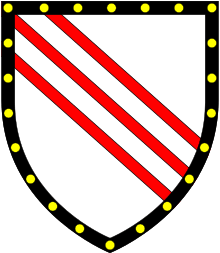Manor of Modbury
The manor of Modbury was a manor covering the ecclesiastical parish of Modbury in Devon. The manor house, last occupied by the Champernowne family and known as "Court House", was situated on the north side of the parish church of St George, on or near the site of Modbury Priory, founded in the 12th century by the Vautort lords of the manor. It was destroyed during the Civil War (1642–1651) and the remnants were sold for building materials in 1705.[1]
Descent
Vautort
The manor of Modbury is listed as two separate parts[3][4] in the Domesday Book of 1086, the principal one as Motbilie, the 64th of the 79 Devonshire holdings of Robert, Count of Mortain,[5] half-brother of King William the Conqueror and one of the Devon Domesday Book tenants-in-chief of that king. Robert's tenant was one of his important Anglo-Norman followers, Reginald I de Vautort (died about 1123), (Latinised to de Valletorta), 1st feudal baron of Trematon in Cornwall,[6] who held 55[7] manors in Devon and Cornwall from Robert, one of which was Modbury.[8] The Vautort family is believed to have originated at the manor of Torteval in Calvados, Normandy.[9] The Vautort family was also feudal baron of Harberton, Devon, and founded Modbury Priory before 1129.[10]
Okeston
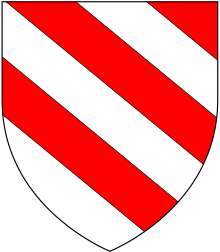
The manor was granted, together with Bridford, by Sir Roger de Vautort to Sir Alexander de Okeston, of Okeston (alias Oxton), Devon,[12] the second husband of Joan de Vautort, widow of Ralph de Vautort, Sir Roger's elder brother.[13] Joan de Vautort was the mistress of Richard, 1st Earl of Cornwall (1209–1272), second son of King John. By Okeston she had a son Sir James Okeston, who before he died childless named as his heir the son of his half-sister Joan, daughter of Earl Richard and wife of Richard Champernowne of Clyst Champernowne, near Exeter, Devon.[14] The Champernown family was thenceforth seated at Modbury. Sir James Okeston (son of Sir Alexander de Okeston) granted Bridford to Richard Champernowne, as evidenced in a deed dated 1314[15]
Champernowne
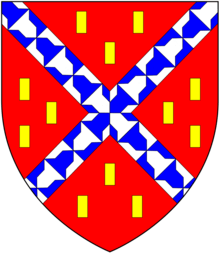
In 1700 Arthur Champernowne (1672–pre-1717) sold Modbury to Nicholas Trist and died childless.[16] A junior branch of the Champernowne family continued at Dartington, Devon, until 1925,[17] being descended from Sir Arthur Champernowne (d.1578) (2nd son of Sir Philip Champernowne (d.1545) of Modbury[18]), who in 1559 purchased the manor of Dartington.[19] The descent of Champernowne of Modbury was as follows:
- Richard Champernowne, second son of Sir Henry Champernowne of Clyst Champernowne and of Ilfracombe, Devon, who married Joan Okeston, heiress of Sir Alexander Okeston[20] of Modbury.
- Sir Richard Champernowne (son),[21] who inherited Modbury by command of King Edward II (1307-1327).[22]
- Sir Richard Champernowne (son), who married Joane Vautort, daughter and heiress of Ralph de Vautort of Tawton.[23]
- Sir Thomas Champernowne (fl.1362) (son), who married Eleanor de Rohant, daughter and heiress of Sir Roger de Rohant of Aston Rohant (today Aston Rowant) in Oxfordshire.[24] As is recorded in the Register of John de Grandisson, Bishop of Exeter from 1327 to his death in 1369, Sir Thomas Champernowne exercised his right of presentation to Modbury Priory on 6 April 1361/2, appointing as Prior Philip de Ffurnariis, following the death of Prior Robert de Curceyo.[25]
- Sir Richard Champernowne (son), who married twice, firstly to Alice Astley, a daughter of Thomas Astley, 3rd Baron Astley (c.1315–1370). His eldest son by Alice Astley was Alexander Champernowne of Bere Ferrers in Devon, who having married Joan Ferrers, the eldest daughter and co-heiress of Martin Ferrers, lord of the manor of Beere Ferrers, made that manor his seat and the seat of son, who died leaving two daughters and co-heiresses.[26] Sir Richard Champernowne married secondly Katherine Daubeney, a daughter of Giles Daubeney, 3rd Baron Daubeney (died 1386)[27] of South Ingleby by his wife Eleanor de Willington. The descendants of this second marriage inherited Modbury.[28]
- Sir Richard Champernowne (d.1418[29]) (son by father's second marriage), who married Isabell Bonville, daughter of John Bonville (d.1396) of Shute and sister of the powerful William Bonville, 1st Baron Bonville (1392-1461).[30]
- Hugh Champernowne (1416-1543/4), son, who married Alice Bois, a daughter of John Bois of Wood.[31] On 18 March 1429/30 Hugh Champernowne appointed William Benselyn as Prior of Modbury, as is recorded in the Register of Edmund Lacey (d.1455), Bishop of Exeter.[32]
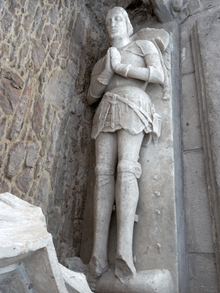
- William Champernowne (d.1464), son, who married Elizabeth Chidderleigh, daughter and heiress of John Chidderleigh.[34] believed to be represented by the surviving alabaster effigy of a recumbent knight in Modbury Church.[35] The effigy is similar to the alabaster effigy of Robert Willoughby, 1st Baron Willoughby de Broke (c. 1452–1502) in Callington Church in Cornwall, both wearing livery collars of roses.[36] Willoughby married Blanche Champernowne, one of the co-heiresses of Champernowne of Bere Ferrers and a half-second-cousin of William Champernowne (d.1464) of Modbury.
- Sir John Champernowne (1458-1503), son, who died at his manor of Aston Rowant in Oxfordshire.[37] He married Margaret Courtenay (c.1459-1504), a daughter of Sir Philip Courtenay (died 1488) lord of the manor of Molland, Devon, Sheriff of Devon in 1470, the second son of Sir Philip Courtenay (1404–1463) lord of the manor of Powderham, Devon, by his wife Elizabeth Hungerford.[38] Margaret Courtenay's sister Elizabeth Courtenay married their distant cousin Edward Courtenay, 1st Earl of Devon (died 1509), KG. Sir John Champernowne's daughter is believed to have been Kat Ashley (c.1502-1565), governess of the future Queen Elizabeth I.
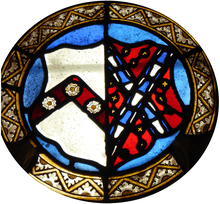
- Sir Philip Champernowne (1479-1545), Sheriff of Devon in 1527, who married Catherine Carew, a daughter of Sir Edmund Carew (d.1513) of Mohuns Ottery in the parish of Luppitt, Devon.[39] In 1528 he sold Aston Rowant in Oxfordshire with appurtenances in Stokenchurch, Chalford, Copcourt, and 'Oxlades' to Henry Courtenay, 1st Marquess of Exeter, 2nd Earl of Devon (c.1498-1538),[40] grandson of Edward Courtenay, 1st Earl of Devon (died 1509). His 2nd son was Sir Arthur Champernowne (c.1524-1578) of Dartington Hall,[41] who purchased that estate in 1559,[42] Sheriff of Devon in 1561. Sir Philip Champernowne's 2nd daughter was Joan Champernowne, wife of Sir Anthony Denny (1501-1549), Groom of the Stool to King Henry VIII. Sir Philip Champernowne's 4th daughter was Katherine Champernowne, who married firstly Otes Gilbert (1513-1546/7) of Greenway in the parish of Brixham and of Compton Castle in the parish of Marldon, both in Devon, by whom she was the mother of Sir Humphrey Gilbert (c.1539-1583); and secondly she married Walter Raleigh (1510–1581) of Fardel Manor in the parish of Cornwood,[43] in South Devon, by whom she was the mother of the famous adventurer Sir Walter Raleigh (c. 1552-1618). The coat of arms of Otes Gilbert and Katherine Champernowne survives in a stained glass window in Churston Ferrers Church, near Greenway.
- Henry Champernowne (1538-1570), grandson, eldest son of John Champernowne, eldest son and heir apparent of Sir Philip Champernowne (1479-1545) (whom he pre-deceased), by his wife Katherine Blount, a daughter of William Blount, 4th Baron Mountjoy. Katherine survived her husband she remarried to Sir Maurice Berkeley (d.1581) of Bruton[44] in Somerset. Henry Champernowne married Catherine Edgcumbe, a daughter of Sir Richard Edgcumbe (d.1562) of Mount Edgcumbe in Cornwall, twice Sheriff of Devon, in 1543 and 1554.[45]
- Sir Richard Champernowne (1558-1622), son, Sheriff of Devon in 1591, created a knight of the Bath in 1599,[46] called by the Devon historian Tristram Risdon (d.1640) "a worthy commander in the wars".[47] In 1581 he married Elizabeth Popham (d.1637), a daughter of Sir John Popham (1531-1607) of Wellington, Somerset, Speaker of the House of Commons, Attorney General and Lord Chief Justice of England. The marriage was without issue.
- Henry Champernowne, nephew and heir, eldest son of Sir Arthur Champernowne (younger brother of Sir Richard Champernowne (1558-1622)) by his wife Amey Crewkerne, daughter and heiress[48] of John Crewkerne of Childhay in Dorset, who remarried to Henry Drake.[49] Henry's inheritance was however limited as according to his relative the Devon historian Sir William Pole (d.1635) (a nephew of Sir John Popham), his uncle Sir Richard Champernowne "hath departed with ye most part of ye land of that auncient famylye".[50] Henry married Mary Coape, a daughter of Sir Anthony Cope, 1st Baronet (1550-1614) of Hanwell in Oxfordshire,[51] a Member of Parliament.[52]
- Philip Champernowne (1618-1684), son, who matriculated at Exeter College, Oxford in 1634, who married firstly a certain Elizabeth (d.1676) by whom he had a son and heir Arthur Champernowne, and secondly to Sarah Calmady (d.1717), widow of John Gubbes of Exeter[53] and a daughter of Edward Calmady (d.1654/5) of Plymouth, 2nd son of Josias Calmady (1565-1611) of Langdon Court in the parish of Wembury in Devon.[54] He was buried at Modbury, where survives his fine incised ledger stone upright against the south wall of south chantry.[55]
- Arthur Champernowne (1671/2-pre-1717), eldest son by father's 2nd marriage, who married twice, firstly to a Hillersdon, a daughter and co-heiress of Richard Hillersdon (d.1703), MP, of Membland in the parish of Newton and Noss, Devon,[56] and secondly to Mary Wise, a daughter of John Wise of Totnes.[57] Both marriages were childless and in 1700, a few years before his death, he sold the manor of Modbury to Nicholas Trist,[58] thus bringing the family of Champernowne of Modbury to a close. The family of Champernowne of Dartington continued in the male line until 1766, and continued via a female line via the heiress Jane Champernowne in the name of Harrington, which family adopted the surname of Champernowne[59] and remained at Dartington until it was sold in 1925 by Arthur Melville Champernowne.[60]
References
- Pevsner, Nikolaus & Cherry, Bridget, The Buildings of England: Devon, London, 2004, p.571
- per Pole, Sir William (d.1635), Collections Towards a Description of the County of Devon, Sir John-William de la Pole (ed.), London, 1791, p.505; A bordure bezantée is a feature in the arms of many families which held under the overlordship of the Earls of Cornwall
- Open Domesday: Modbury, accessed April 2020.
- Thorn, 15:49 & 15:64
- Thorn, Caroline & Frank, (eds.) Domesday Book, (Morris, John, gen.ed.) Vol. 9, Devon, Parts 1 & 2, Phillimore Press, Chichester, 1985, Part 2 (Notes), 15:64
- Bearman, Robert, biography of Vautort family, Oxford Dictionary of National Biography, Vol.56, 2004, p.214
- Bearman, Robert, biography of Vautort family, Oxford Dictionary of National Biography, Vol.56, 2004, p.214
- Thorn, Caroline & Frank, (eds.) Domesday Book, (Morris, John, gen.ed.) Vol. 9, Devon, Parts 1 & 2, Phillimore Press, Chichester, 1985, 15:64
- Bearman
- Bearman
- Pole, p.495
- "Oxton manor house on the road between Chudleigh and Exeter", per Hamilton, Dom. Adam, OSB, History of St Mary's Abbey of Buckfast, 1906, p.92 . This is Oxton in the parish of Kenton; see Pole, p.257, who mentions an Alexander de Oxton, but makes no mention of a connection with Vautort
- Pole, Sir William (d.1635), Collections Towards a Description of the County of Devon, Sir John-William de la Pole (ed.), London, 1791, pp.248, 309
- Risdon, p.129
- Risdon, p.129: regnal year 8 Edwardus filius Edwardi (ie "Edward son of Edward", thus King Edward II
- Vivian, p.165, pedigree of Champernown
- Burke's Genealogical and Heraldic History of the Landed Gentry, 15th Edition, ed. Pirie-Gordon, H., London, 1937, p.384, pedigree of "Champernowne of Pound and formerly of Dartington"
- Vivian, pp.162-3
- Pevsner, Nikolaus & Cherry, Bridget, The Buildings of England: Devon, London, 2004, p.311
- Vivian, p.160
- Vivian, p.160
- Risdon, p.187
- Vivian, p.160
- 'Parishes: Aston Rowant', in A History of the County of Oxford: Volume 8, Lewknor and Pyrton Hundreds, ed. Mary D Lobel (London, 1964), pp. 16-43 [accessed 16 February 2019]; called in Vivian, p.162 "Roger de Rohart"
- Oliver, p.298 Thome de Campo Arnulphi, domino Modburie ("by Thomas Champernowne, lord (of the manor) of Modbury")
- Vivian, p.162
- Vivian, p.162 "Sir Giles Daubeney", stated by www.tudorplace.com to be 3rd Baron Daubeney
- Vivian, p.162
- Vivian, p.162
- Vivian, p.162; pp.101-2, pedigree of Bonville
- Vivian, p.162
- Oliver, p.298
- Pevsner, p.570 "effigy c.1460"
- Vivian, p.162
- Pevsner, p.570 "effigy c.1460"
- see File:RobertWilloughbyCallington.jpg)
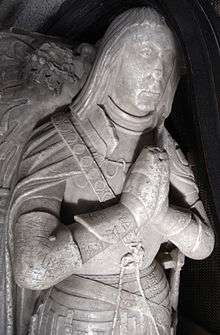
- Vivian, p.162
- Vivian, p.162 (pedigree of Champernowne), pp.246,251 (pedigree of Courtenay)
- Vivian, Lt.Col. J.L., (Ed.) The Visitations of the County of Devon: Comprising the Heralds' Visitations of 1531, 1564 & 1620, Exeter, 1895, p.639, pedigree of Raleigh; p.405, pedigree of Gilbert of Compton; p.162 pedigree of Champernowne
- 'Parishes: Aston Rowant', in A History of the County of Oxford: Volume 8, Lewknor and Pyrton Hundreds, ed. Mary D Lobel (London, 1964) (relationship stated incorrectly)
- Vivian, p.163
- Pevsner, p.311
- Pevsner, Nikolaus & Cherry, Bridget, The Buildings of England: Devon, London, 2004, p.288
- Vivian, p.163
- Vivian, Lt.Col. J.L., (Ed.) The Visitations of Cornwall: Comprising the Heralds' Visitations of 1530, 1573 & 1620; with additions by J.L. Vivian, Exeter, 1887, p.142
- Vivian, p.165
- Risdon, Tristram (d.1640), Survey of Devon, 1811 edition, London, 1811, with 1810 Additions, p.187
- Pole, p.310
- Vivian, p.165
- Pole, p.310
- Pole, p.310; Risdon, p.187
- https://www.historyofparliamentonline.org/volume/1604-1629/member/cope-sir-anthony-1550-1614
- Vivian, pp.165, 129, pedigree of Calmady
- Vivian, pp.128-9, pedigree of Calmady
- Historic England. "Details from listed building database (1108059)". National Heritage List for England. Retrieved 16 February 2019.
- Crossette, J. S., biography of Hillersdon, Richard (c.1639-1703), of Membland, Holbeton, Devon, published in History of Parliament, House of Commons 1660–1690, ed. B.D. Henning, 1983
- Vivian, p.470
- Vivian, p.165
- Vivian, p.164
- Burke's Genealogical and Heraldic History of the Landed Gentry, 15th Edition, ed. Pirie-Gordon, H., London, 1937, p.384; Pevsner, p.311
